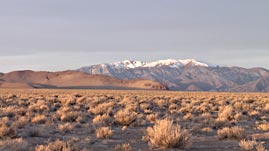Teachers' Domain - Digital Media for the Classroom and Professional Development
User: Preview

Source: A Haskell Indian Nations University production for NASA's Where Words Touch The Earth



This video segment examines the issue of climate change from the perspective of Native Americans. Elders describe the changes they have observed in their surroundings, especially those related to water, and the effects they are having on their way of life. Dr. Daniel Wildcat explains that because Native people are so deeply connected to the land, non-Native people should consult with Native people about what we are experiencing. The video segment was adapted from a student video produced at Haskell Indian Nations University in Lawrence, Kansas.
For the first time in history, the majority of people worldwide reside in cities. Walks in the great outdoors are being replaced by walks in indoor shopping malls. The sound of birds is giving way to the sound that emanates from MP3 players. As humans become more engaged with the built environment and digital technologies, they become less connected with nature. Many would argue that this disconnection has led to a global crisis in the form of climate change.
Yet there are people on the planet who continue to pay very close attention to nature. They possess an awareness acquired not through classroom study or media reports, but through direct experience in their daily activities. The word indigenous means "originating in a particular region or territory," or "native." Recent estimates of the world’s indigenous population range from 300 million to 350 million people. This represents about 5 percent of Earth's 6.7 billion human inhabitants. Native American is the blanket term for indigenous peoples in the United States and includes American Indian and Alaska Native populations. According to the 2000 United States Census, 2.4 million people reported their race as "single-race" Native American. An additional 1.9 million people reported that they were of multiple races, including either American Indian or Alaska Native.
Indigenous knowledge, also referred to as natural intelligence, is understanding gained by a people through their practical experience with a place. For many indigenous peoples around the world, their attentiveness to nature is born of subsistence living, in which they rely on natural resources for food, clothing, and shelter. They harvest natural resources from the land and water using traditional methods and a deep knowledge of the geography, climate, and wildlife of their local area. For example, as the seasons change and the availability of resources changes, so do their hunting and gathering activities change. Native peoples' intimacy with nature is such that they pick up on subtle changes in environmental conditions that are not seen by casual observers who do not spend their days immersed in nature. In this video, Native people trace the decline in trout, a valued food source, to the scarcity of water running down from the mountains.
Native Americans have long recognized and celebrated the connectedness among all natural things. Like other indigenous cultures, they have survived for thousands of years by living close to the land and by adapting to changes in climate and weather as well as in wildlife availability. Native people argue that non-native societies should look to use indigenous knowledge to help preserve the health of the planet. Bringing Native thinkers into the fields of planning and assessment may be an effective strategy.
 Loading Standards
Loading Standards Teachers' Domain is proud to be a Pathways portal to the National Science Digital Library.
Teachers' Domain is proud to be a Pathways portal to the National Science Digital Library.
